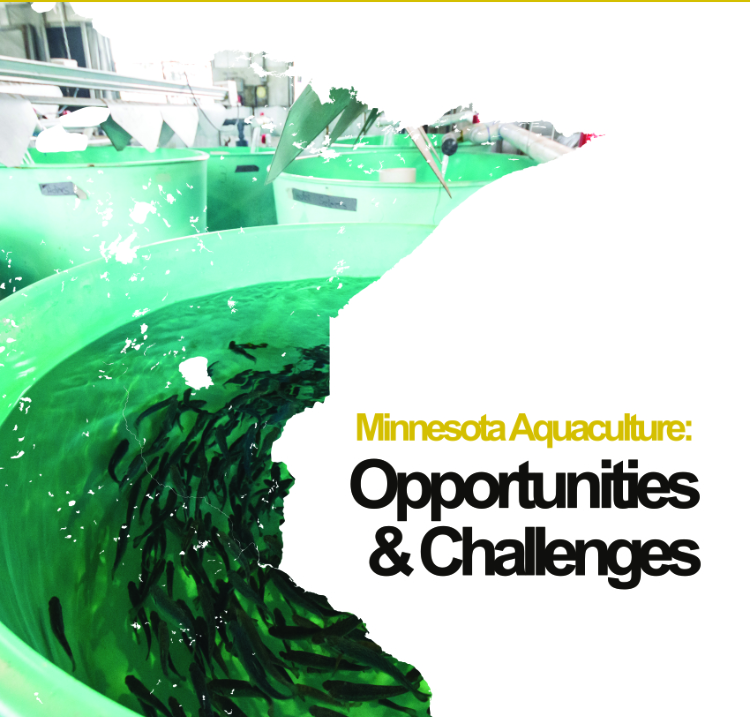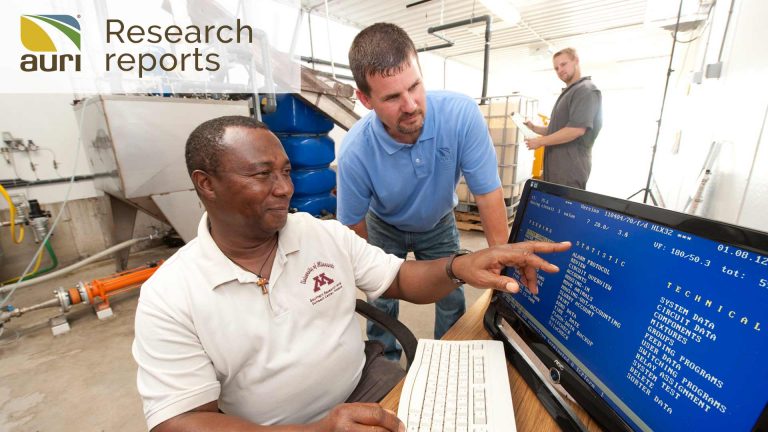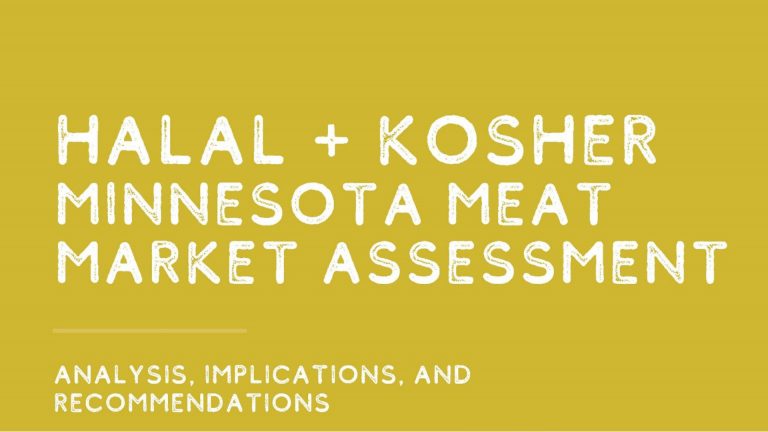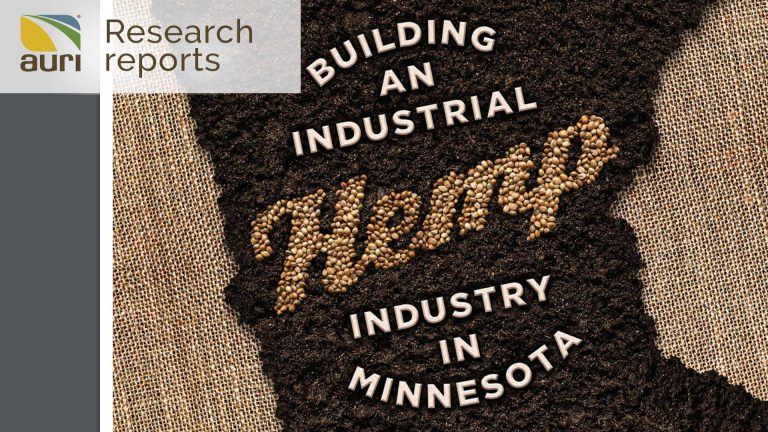Access AURI Services
Home | Research Reports
Research Reports
AURI conducts practical, applied research that identifies emerging opportunities to add value to agriculture products. This information is publicly available with the hope that it will spur ideas for new products and processes.
Browse the archive of research below, or search for your area of interest.
Refine your search
The United States Department of Agriculture-Agricultural Research Service (USDA-ARS) and the University of Minnesota (UMN) conducted a research project to test whether carbon (C)
The United States Department of Agriculture-Agricultural Research Service (USDA-ARS) conducted a research project to investigate the performance of agriculturally derived residue materials in bioreactors.
A new report that assesses the current state of “ready to scale” food and beverage businesses. Continue Reading Food & Beverage Manufacturing
Globally, aquaculture is one of the fastest-growing food industries. The key drivers are technological developments, increased production, and growing understanding of the health benefits
Food fish comprise a diverse category in Minnesota from its legendary walleye to trout. Besides wild caught fishing, which goes back
many generations, commercially viable
Potential for cost savings is an important driver for new asphalt pavement preservation techniques. This study evaluated the cost effectiveness of RePlay Agricultural Oil
This report illustrates the impact of the novel Coronavirus Disease (COVID) on supply chains for Minnesota food and agriculture manufacturers and processors. A collaboration
This research identifies and evaluates more sustainable packaging options that improve consumer confidence by providing tangible and consumer-visible demonstrations of the beef industry’s commitment
Small to mid-sized food manufacturers represent a growing sector within the food industry, and as such have the potential to provide new market channels
The markets for halal and kosher meat in Minnesota hold untapped potential for communities throughout the state. On the consumer side, Minnesota is home
AURI is pleased to present this preview of an upcoming Minnesota Hemp Value Chain Analysis report to the growers, governments, supply chain sectors and
AURI was interested in quantifying the contribution of its programs in Minnesota. Thus, you hired University of Minnesota Extension to conduct an economic contribution
The report contains information on plant protein sources that are currently available, emerging, or potentially viable sources of proteins. It summarizes current knowledge, advantages,
In August 2017, AURI and the Stine Group emailed a survey to 167 Nutrition Services Directors (NSDs) in 120 Minnesota school districts. The goal
Read the full report: Development of a Port-Injected Hydrous Ethanol System for Diesel Engines Continue Reading Development of a Port-Injected Hydrous Ethanol
Read the full report: Effects of Feeding Reduced-Fat Modified Distillers Grains with Solubles on Dietary Energy Values, Finishing Cattle Performance and Beef Quality Characteristics
Information detailed in this study guide can be utilized to make informed decisions on the feasibility of utilizing a biomass system, whether as a
The potential long-term outcome of this research is the development and promotion of on-farm energy production using a combination of corn stover and distillers
This research demonstrates that ethanol plants can grow this particular market for their feed products, while livestock producers get a simple, low-cost, effective feed
Results indicate feeding high levels of corn or soy coproducts in feedlot heifer diets does not have an effect on carcass characteristics, drip loss,
This research can help direct cattle producers on design, construction and management of their feeding operations to effectively raise cattle along with gaining greater
Reduced oil concentration in DDGS has minimal, if any, effect on growth performance and carcass com The reduced oil concentration in DDGS generally improves
This research was to work to understand consumers’ perceptions about various fluid milk products that are available in the market. This research looked at
Thin stillage from corn ethanol plants is currently utilized by adding it to DDG and subsequently drying the blended streams to yield DDGS. This
This project shows that feeding DDGS does not cause defects in Swiss cheese; and can be utilized by ethanol and dairy producers when making
This study suggests that reduced-fat distillers grains can replace full-fat distillers grains in feedlot diets without having a negative impact on growth performance, carcass,
Results from this project will provide information regarding whether or not feeding DDGS is a causative factor in foaming of swine manure and provide
Agbioscience is a critical component of Northeast Minnesota’s past and future. A new research report shows that in 2013 agbioscience supported $2.1 billion in
This project was driven by the building and trade industry’s desire for an alternative to many petroleum base resins. The industry is looking for
Agbioscience is a critical component of Northwest Minnesota’s past and future. A new research report shows that in 2013 agbioscience supported $789.4 million in
Agbioscience is a critical component of Central Minnesota’s past and future. A new research report shows that in one year alone agbioscience supported $2
Agbioscience is a critical component of Southwest Minnesota’s past and future. A new research report shows that in one year alone agbioscience supported $2.6
“This report helps us understand what the agbioscience industry contributes to our region’s economy,” says Sandy King, interim CEO for West Central Initiative. “Through
“This research report reinforces what we know is a critical strength for our region—agriculture and the associated biosciences—and, specifically, value-added food production,” says Tim
“This initiative is about creating a vision and strategy to transform Minnesota’s fundamental strength in agriculture into leading-edge innovation and economic growth for the
Dietary fibers are a growing food ingredient market. Oligosaccharides are prebiotic fiber compounds that enhance the digestive health of the lower gastrointestinal tract. This study uses
The objective of this study was to assess the effect of feeding crude glycerol or minimally‐refined cottonseed oil on growth performance, carcass composition and
The purpose of this project is to use hydrous ethanol to demonstrate high efficiency with reduced emissions in a modified diesel engine where ethanol
The report details the determination of metabolizable energy of reduced oil DDGS for turkeys so that poultry nutritionists could be provided with more accurate
The objective of this study was to compare the performance of pigs fed diets containing 20% distillers’ dried grains with solubles (DDGS) to that
The bioplastics industry is continuing to grow and expand. This report looks at the biobased materials industry in Minnesota. Continue Reading Marketplace
More research needs to be conducted to learn more of the inter-relationships of amino acids for turkey. While this study emphasized valine and tryptophan
A survey was conducted of Minnesota-based agricultural product processors to identify which, if any, lower value coproducts may present opportunities for value generation beyond
This project carried out the experimental research to investigate whether Listeria monocytogenes, a major food safety pathogen, is capable of surviving in sliced process
This study was initiated to determine the needs of the meat processing industry in Minnesota. Project outcomes: The findings are intended to be informative
This study aims to assess the bio‐methane potential of sieved dairy manure with different organic byproducts including condensed distillers solubles (CDS) and cheese whey.
A recent survey, sponsored by the Minnesota Landscape and Nursery Association (MNLA) and AURI, found that nursery and landscape businesses in Minnesota have experienced
Overall, results indicated that DLW subjected to controlled and limited/moderate hydrolysis can easily replace whey protein isolates in processed meat applications. The use of
This report examines whether a glucose meter could be used to determine the lactose content of milk. Continue Reading Rapid measurement of
This project researched the chemical conversion of bioethanol to produce a more valuable commodity chemical, ethylene carbonate, and determine if this conversion is viable
Over the past five decades, researchers have investigated factors that influence the occurrence of ‘spontaneous oxidized off‐flavor’ in milk; however, the conclusions from this
A new report out shows that Minnesota’s economic future may well be rooted in its historic leadership in agricultural production. Continue Reading
Heat stress reduces livestock productivity and this may in part be by reduced intestinal integrity or “leaky gut”. Dairy products improve intestinal integrity in
The use of twin-screw extrusion to produce puffs and crisps for cereals and snacks is widely utilized in the food industry. Soy protein is
Results from this study suggest that the inclusion of modified distillers grains plus solubles and crude glycerin in beef cattle finishing diets did not
During this research, selective extraction of Dried Distillers Grains with Solubles (DDGS) produced several valuable materials. Using a process developed at the Natural Resources
Whey is a protein‐rich liquid component of milk that is produced as a byproduct of the cheesemaking. The health benefits of consuming whey have
A major ingredient in pig’s feed is corn. The use of corn in ethanol production also results in the generation of byproducts that have
A new research report looks at whether the content of low-fat distillers grains could attenuate negative effects of high dietary fat on ruminal fermentation,
A major economic loss for shredded cheese manufacturers is product return because of mold growth. Currently used antifungal agents such as potassium sorbate and
High fat and high sulfur concentrations in traditional distillers grains plus solubles limit inclusion rates in feedlot cattle diets. High dietary sulfur concentrations are
Read the complete report: Interaction of distillers grains on sulfur concentration and dietary roughage on microbial fermentation About this report: The increase in ethanol
Read the complete report: Determination of potential human health benefits from diets containing corn distillers coproducts About this report: The goal of this project
Read the complete report: Implications of corn producer participation in stover biomass markets and availability About this report: Growing the next generation of renewable
Read the Mid-Project Preliminary Research Report: Dairy Digester System About This Report This report gives an update on proposed enhancements to the dairy digester
Read the complete report: Investigation of relationship of chemical composition, viscosity, and metabolizable energy of distillers grains for poultry About this report: The overall
Read the complete report: Effects of DDGS nutrient composition (reduced‐oil) on digestible and metabolizable energy value and prediction in growing pigs About this report:
Read the complete report: Vitamin E and selenium status of pigs fed DDGS diets and relationship to Mulberry Heart Disease About this report: In
Read the complete report: Value-Added Opportunities and Alternative Uses for Wheat and Barley About This Report The overarching objective of the “Value-Added Opportunities and
Read the report: Biofilm formation on dairy separation membranes as affected by the substrate and cheese starter About this report: The objectives of the
Read the complete report: DDGS and E.Coli in Cattle Diets: A Two-Part Study About This Report Ethanol plants and cattle producers create a symbiotic relationship: The
Read the Mid-Project Preliminary Research Report: Optimization of denitrifying bioreactor performance with agricultural residue-based filter media About This Report Wood-chip denitrifying bioreactors are one
Read the complete report: How Alternative Feed Ingredients Affect Poultry Dietary Electrolyte Balance About This Report Dried distillers grains with solubles (DDGS), derived primarily
Read the complete report: Water Reuse for Agricultural Processing (A Community Case Study) About This Report The Agricultural Utilization Research Institute (AURI) recognizes the
Read the complete report: Potential Health Benefits of Wild Rice and Wild Rice Products (Literature Review) About This Report Wild rice has long been
Read the complete report: Mechanical Dewatering Technolgies for Wet Biomass View the presentation: Dewatering Technologies for Wet Biomass About This Report Many wet biomass
The objective of this study was to determine potential biomass resources within the Midwest for thermal heating applications in order to provide a “snapshot”
The research objective of this experiment was to replace 35% of dry rolled corn in traditional corn-based feedlot diets with a high protein dried
Use of manganese oxide to attenuate negative effects of high sulfur concentrations in distillers grains-based finishing rations File Attached: Manganese_Oxide_Final_Report_to_AURI_and_MCRPC_November_2011.pdf
The Economic Research Service of the U.S. Department of Agriculture (USDA) and the Ford Foundation are convening a National Conference and Conversation on Rural
This study evaluated alternate media as well as media mixes that could be used as bedding for compost barns. The goal is to help
As the interest and use of biobased products grows, so do the opportunities and challenges. According to a recent report sponsored by AURI and
There is a demand for barley straw as an odor control mechanism however, transportation issues limit the use of it as a marketable product.
Read the report: Evaluation of different cleaning agents for the removal of membrane biofilms About this report: Dairy concentration membranes are prone to biofouling,
Read the report: Modifications in the CIP protocols for removing biofilms on whey RO membranes About this report: This report looks to evaluate a
The purpose of this initiative is to investigate drying technologies that might make the drying process more economical, and make the use of post-digester
The agriculture industry is abundant and the potential for biogas production is significant in northwest Minnesota. Biogas, or methane, is produced through a processof
Food and beverage producers have been using anaerobic treatment of their production wastewaters for decades. These systems have become increasingly popular in recent years
AURI has received several requests for technical assistance related to omega-3 and omega-6 fatty acids and the allowed health claims for products containing these
Read the report: Role of bacterial cell-dairy separation membrane interaction on biofilm formation About this report: The purpose of this report was to study
Glycerol is a sugar alcohol by-product of bio-diesel production. About 1 gallon of glycerin is produced for every 10 gallons of bio-diesel. This report
In 2007, the State Legislature and Governor enacted legislation to put Minnesota on a path to have 25 of its energy produced from renewable
On June 30th, the Minnesota Food Innovators Network (Mn-FIN) came together for the first time to begin a conversation about creating a network that
Reclaimed municipal wastewater may be a useful resource for agricultural processing. Reusing waste water could help save valuable water resources while benefitting agricultural processing
Land application of industrial materials and by-products has been common for decades. Recent expansion of the biofuel industry has resulted in significantly large quantities
Minnesota’s food industry may provide significant opportunity for growing jobs that are considered green. This comprehensive report takes a look at where those opportunities
Phase III of Converting Thin Stillage into Renewable Energy, Renewable Fertilizer, and Recyclable Water File Attached: Phase_III_Report_Final.pdf
An evaluation of glycerol, a biodiesel coproduct, in grow-finish pig diets to support growth and improve pork quality. Part of a large collaboration between
This report details the effects of DDGS source on growth performance and carcass characteristics of growing-finishing pigs. Part of a collaboration between MN Pork
This report studies the effects of increasing glycerol and dried distillers grains with solubles on the growth performance and carcass characteristics of finishing pigs.
This report details results of the use of crude glycerol, a bio-diesel coproduct, in diets for lactating sows. Part of a large collaborative project
This publication reveals results of a study pertaining to energy determination of corn co-products fed to finishing pigs and use of in vitro OM
The corn cob field-to-facility project is a success in that it has demonstrated and documented the viability of corn cobs as a sustainable source
A comprehensive report detailing new opportunities for corn growers in Minnesota. File Attached: Informa_Corn_Report_Final.pdf
Comprehensive report on new opportunities for soybean growers in Minnesota. File Attached: Informa_Soybean_Report_Final.pdf
This project looks at different densification technologies throughout the world to bring the most economical and efficient technology to Minnesota. Biomass densification is one
AURI operates an analytical laboratory capable of performing both instrumental and wet chemistry tests suitable for defining physical and chemical characteristics of a variety
The Agricultural Utilization Research Institute (AURI), in conjunction with the Center for Producer Owned Energy, Aitkin County Land Department, and the Aitkin County Economic
There is growing interest among consumers in knowing the origins of the food they eat. This is also creating opportunities for producers. A market
The AURI Fuels Initiative II Brochure is provided to use as a general comparative guide for agricultural renewable fuels. The evaluated agricultural renewable fuel
Interest in developing biofuels from renewable ingredients, including agricultural products, remains strong. While many developments that are occurring are larger scale, opportunities may not
Among the key issues facing further development of renewable energy in Minnesota is the availability of trained, qualified employees. A Biofuels Needs Assessment was
Microwave drying is an emerging technology that could be used as an alternative to the current method which most often uses heat from burning
Wind farms are springing up throughout Minnesota as efforts are made to capture the energy of the wind. While some of these farms and
By the end of 2008, the National Biodiesel Board estimates the nation’s biodiesel production capacity will exceed 1.3 billion gallons per year. Producing that
As the biodiesel industry grows, so does the nation’s supply of glycerin. Refined glycerin is used in thousands of products from food to toothpaste
Minnesota has a growing biodiesel industry, highlighted by several producer-owned plants and more than 60 million gallons of annual production capacity. While the industry
Read the complete report; The Emerging Biobased Economy About This Report The purpose of the study is to provide analytic insight and foundations needed
This report was conducted by AURI on behalf of the MN Corn Growers Association. File Attached: Flowability_summary_10_17_05.pdf
Minnesota farmers produce thousands of acres of oilseeds including soybeans, canola, sunflowers and more. But the amount of oilseeds processed in the state is
View our corn stoves brochure, which contains information about corn and pellet fuel manufacturers in Minnesota, as well as how moisture level in the
In an effort to reach possible new markets, interest in producing alternative livestock has grown among Minnesota producers. For many of these species, little
The purpose of this study is to estimate the economic impact of meat/milk processing plants to the state’s economy and community vitality. This study
As the biodiesel industry grows, so does the nation’s supply of glycerin. Refined glycerin is used in thousands of products from food to toothpaste
AURI Development and Utilization of Agricultural Co-Products Program seek utilization ideas for plant and animal by/co-products that present environmental and economic opportunities. The development
With the fluctuating cost of soybean meal and synthetic lysine, many producers are faced with looking for cost effective alternatives for this limiting amino
According to the U.S. Bureau of the Census, Minnesota can expect one hundred and ninety thousand foreign immigrants between 1995 and 2025. During a
Livestock producers in Minnesota and elsewhere are seeking ways to deal with manure from their operations in a safe, efficient and sustainable way. Among
Anaerobic digesters are not necessarily a fit for every operation. There are multiple considerations that should be addressed prior to installing these digesters. File
There is growing interest among consumers in knowing the origins of the food they eat. This is also creating opportunities for producers. A market
Candle making can be a simple process when you aren’t attempting to make the perfect candle. You simply melt the wax, add the dye
AURI Development and Utilization of Agricultural Co-Products Program seek utilization ideas for plant and animal by/co-products that present environmental and economic opportunities. The development
Food labeling is mandated by federal and state laws to ensure accurate representation of the product. The FDA regulations on labeling are written in
HACCP is an acronym that stands for Hazard Analysis and Critical Control Point. HACCP is a science-based system for assuring the safety of food
510 County Road 71, Suite 120, Crookston, Minnesota 56716










